NCERT Solutions for Class 5 Maths Chapter 11 Area and Its Boundary
NCERT Textbook Page 146
Whose Slice is Bigger?
Parth and Gini bought aam paapad (dried mango slice) from a shop. Their pieces looked like these.Both could not make out whose piece was bigger.
1.Suggest some ways to find out whose piece is bigger. Discuss.
Ans. To decide whose piece is bigger following ideas can be used.
Idea 1: First of all let us cut the piece B as shown here.
Now, put the first and second parts over the piece A.
Conclusion: It is observed that the first and second parts exactly cover the piece A. But the third part is remaining which shows that part B is bigger than part A. ,
Idea 2: We can divide the pieces A and B into 1 cm squares in the following way.
Now, let us count the number of small boxes in each piece. There are 30 boxes in piece A.
There are 33 boxes in piece B.
So, piece B is bigger than piece A.
NCERT Textbook Page 147
1.Altogether how many squares can be arranged on it?
Ans. 30 squares can be arrange on it.
2.So the area of piece A =————-Square cm
Ans. 30 square cm (An easier way is to multiply 5 with 6 to get 30)
3.In the same way find the area of piece B.
Ans. You can divide the area of piece B into 33 boxes of 1 square cm. So, area of B is 33 square cm.
4.Who had the bigger piece? How much bigger?
Ans. Piece B had the bigger area by (33 – 30) = 3 square cm.
Cover With Stamps
1.The stamp has an area of 4 square cm. Guess, how many such stamps will cover this big rectangle.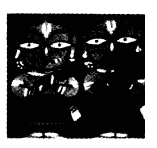
Ans. My guess is 20 stamps.
NCERT Textbook Page 148
Check Your Guess
(a)Measure the yellow rectangle. It is ……………….. cm long.
Ans. 12 cm
(b)How many stamps can be placed along its length?………………..
Ans. 6 stamps
(c)How wide is the rectangle?……………….. cm
Ans. 8 cm
(d)How many stamps can be placed along its width?………………..
Ans. 4 stamps (Because 8 + 2 = 4)
(e)How many stamps are needed to cover the rectangle? ………………..
Ans. 6 x 4 = 24 stamps
(f) How close was your earlier guess? Discuss
Ans. It was pretty close.
(g) What is the area of the rectangle?………………… square cm.
Ans. 4 square cm x 24 = 96 square cm
(h) What is the perimeter of the rectangle?……………….. cm
Ans. Perimeter = 2 (12 + 8) = £ x 20 = 40 cm
NCERT Textbook Page 148
Practice Time
(а)Arbaz plans to tile his kitchen floor with green square tiles. Each side of the tile is 10 cm. His kitchen is 220 cm in length and 180 cm wide. How many tiles will he need?
Ans. Area of floor = length x width
= 220 x 180 = 39600 square cm Area of a tile = Side x Side
= 10 x 10 = 100 square cm Number of tiles = Area of floor + Area of tile
= 39600 + 100 = 396 tiles
(b)The fencing of a square garden is 20 m in length. How long is one side of the garden?
Ans. Perimeter of garden = 20 m
Hence, length of each side = 20 + 4 = 5 m
(c) A thin wire 20 cm long is formed into a rectangle. If the width of this rectangle is 4 cm, what is its length?
Ans. Perimeter = 20 cm
Width = 4 cm
We know, perimeter = 2(length + breadth)
Hence, 2 (length + breadth) = 20
Or, length + 4 = 20÷2 = 10
Or, length = 10 – 4 = 6 cm
(d)A square carromboard has a perimeter of 320 cm. How much is its area?
Ans. Perimeter = 320 cm
We know, perimeter = 4 x Side Hence, 4 x Side = 320 cm Or, Side = 320 4 = 80 cm
Now, area = Side x Side
= 80 x 80 = 6400 square cm
(e)How many tiles like the triangle given here will fit in the white design? Area of design =………. square cm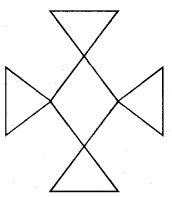
(Hint: This triangle is half of the cm square)
Ans. As is clear from the above figure, the design needs 6 such triangles.
Area of design = 6 x 1/2 = 3 square cm.
Make your own designs of area 4 square cm and 6 square cm.
As two triangles make 1 square cm so,
For a design of 4 square cm. we need 4×2 = 8 triangles
And for a design of 6 square cm we need 6 x 2 = 12 triangles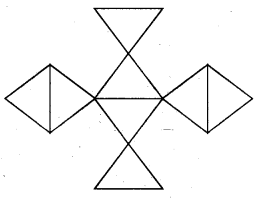
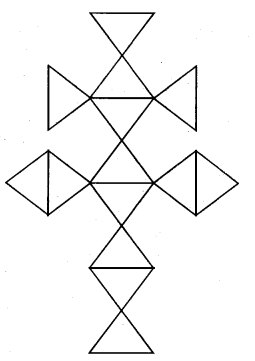
(f) Sanya, Aarushi, Manav and Kabir made greeting cards. Complete the table for their cards:
Ans.Sanya
We have length = 10 cm and width = 8 cm
Perimeter = 2(Lehgth + Width)
Manav = 2(10 + 8)
= 2 x 18 = 36 cm Area = Length x Width
= 10 x 8 = 80 square cm
We have length = 11 cm and Perimeter = 44 cm
Perimeter = 2(Length + Width)
or, 44 = 2(Length + Width)
or, Length + Width = 44 2 = 22
or, 11 + Width = 22
Hence, Width = 22 – 11 = 11 cm –
Now, area = Length x Width 1
Aarushi
We have = 11×11 = 121 square cm width = 8 cm and area = 80 square cm
Area = Length x Width Or, Length x 8 = 80
Or, Length = 80 -5- 8 = 10 cm
Perimeter = 2(Length + Width)
= 2(10 + 8) = 2 x 18 = 36 cm
Kabir
We have Perimeter = 40 cm and area = 100 square cm Hence, 2(Length + Width) = 40 cm Or, Length + Width = 40 + 2 = 20
And, Length x Width = 100
Let us factorize 100 in such a way that both factors add up to 20 100 = 2 x 50; But 2 + 50 = 52 100 = 4 x 25; But 4 + 25 = 29 100 = 5 x 20; But 5 + 20 = 25 100 = 10 x 10 and 10 + 10 = 20 So, Length = 10 cm and width = 10 cm
NCERT Textbook Page 149
My Belt is Longest!
1.Take a thick paper sheet of length 14 cm and width 9 cm. You can also use an old postcard.
What is its area? What is its perimeter?
Now cut strips of equal sizes out of it.
Using tape join the strips, end to end, to make a belt.
How long is your belt?
What is its perimeter?
Whose belt is the longest in the class?
Ans. Area of rectangle = Length x Breadth
Hence, area of the paper sheet = 14 x 9
= 126 square cm Perimeter = 2(length + breadth)
= 2(14 + 9)
= 2 x 23 = 46 cm
Now, let us cut the sheet in strips of following widths:
Strip of width 1 cm
We can have 9 strips of width 1 cm.
Joining 9 such strips will give a belt of length 9 x 14 = 126 cm
Strip of width IV2 cm
We can have 6 strips of width IV2 cm
Joining 6 such strips will give a belt of length 6 x 14 = 84 cm
Strip of width 3 cm
We can have 3 strips of width 3 cm
Joining 3 such strips will give a belt of length 3 x 14 = 42 cm Let us assume that I made the belt of 3 cm wide strips.
Then perimeter of the belt = 2(length + breadth) .
= 2(42 + 3)
= 2 x 45 = 90 cm
Observation: Strips of the least width will make the longest belt in the class.
NCERT Textbook Page 150
Discuss
1.Why did some of your friends get longer belts than others?
Ans. Because they made belts from thinner strips than others.
2.Is the area of your belt the same as the area of the postcard? Why or why not?
Ans. Area of the belt of 3 cm wide strip = length x breadth = 3 x 42 = 126 square cm Yes, this is equal to the area of the postcard.
In fact, area of all the belts would be equal to the area of the postcard; because every part of the postcard is being used in making a belt.
3.What will you do to get the longer belt next time?
Ans. By making thinner belts; I can get longer belt the next time.
Puzzle
Pass through a Postcard
1.Can you think of how to cut a postcard so that you can pass through it?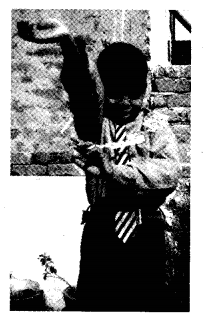
Ans. Yes, I can pass through a postcard by making a loop from it. The steps are given below.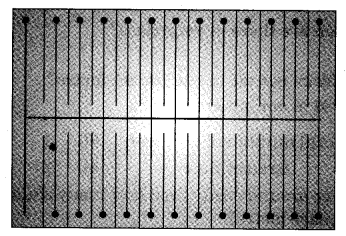
Make lines on the postcard as shown in this figure.
Cut the postcard along the lines which touch its border. This will make loop as shown here.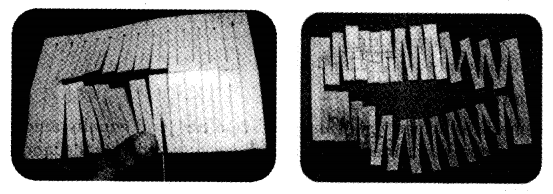
NCERT Textbook Page 151
People, People Everywhere
You can play this game in a ground. Make two squares of one square metre each. Divide your class in two teams. Ready to play!
Try these in your teams:
1.How many of you can sit in one square metre?
Ans. Three
2.How many of you can stand in it?
Ans. Four
3.Which team could make more children stand in their square? How many?
Ans. Team A could make five children stand in their square.
4.Which team could make more children sit in their square? How many?
Ans. Team A could make four children sit in their square.
Measure the length of the floor of your classroom in metres. Also measure the width.
Ans. Length = 10 m and width = 8 m ‘
5.What is the area of the floor of your classroom in square metre?
Ans. Area = Length x Breadth
= 10 x 8 = 80 square metre
6.How many children are there in your class?
Ans. 40 children.
7.So how many children can sit in one square metre?
Ans. Number of children in one square metere
Total lumber of children / Area of floor=80/40= 1/2
8.If you want to move around easily then how many children do you think should be there in one square metre?
Ans. Two children.
NCERT Textbook Page 152
1.Can you imagine how big a square of side 1km is! It has an area of square km. Guess how many people can live on that.
Ans. Area =1 x 1 = 1 square km
About 1000 people can live on that.
Share the Land
Nasreema is a farmer who wants to divide her land equally among her three children-Chumki, Jhumri and Imran. She wants to divide the land so that each piece of land has one tree. Her land looks like this.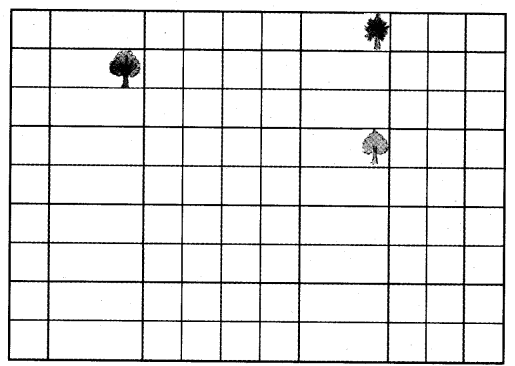
2.Can you divide the land equally? Show, how will you divide it. Remember each person has to get a tree. Colour each person’s piece of land differently.
Ans. Total number of boxes = 90
Hence, one person’s share = 90 + 3 = 30
The division can be done as the given figure.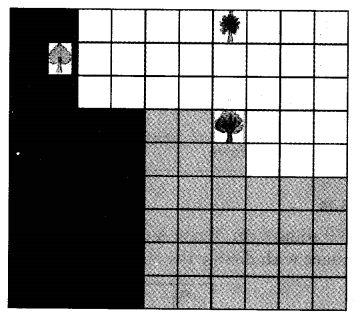
3.If each square in this page is equal to 1 square metre of land, how much land will each of her children get? Square m
Ans. 30 square metre
4.Chumki, Jhumri and Imran need wire to make a fence.
Who will need the longest wire for fencing?
Ans. Perimeter of Chumki’s land
= 9 + 2 + 3 + 2 + 6 + 4 = 26 m
Perimeter of Jhumri’s land
= 6 + 3 + 2 + 3 + 4 + 6 = 24 m
Perimeter of Imran’s land
= 8 + 5 + 3 + 2 + 5 + 3 = 26 m
It is clear that Chumki and Imran need the longest and equal wires to fence their lands.
5.How much wire in all will the three need?
Ans. Total length of wire
= 26 + 24 + 26 = 76 m
NCERT Textbook Page 153
Practice Time
1.Look at the table. If you were to write the area of each of these which column would you choose? Make a (Right)
Ans.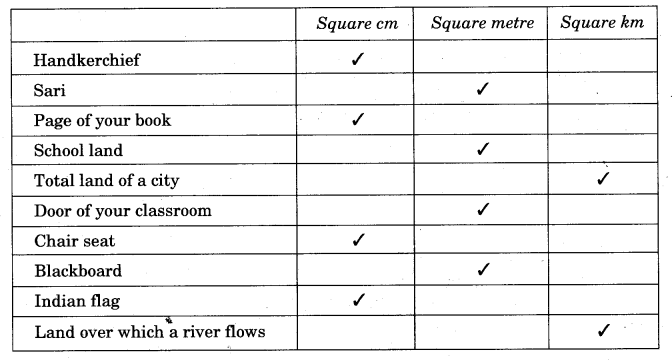
NCERT Textbook Page 154
1.Draw a square of 9 square cm. Write A on it.
Draw another square with double the side. Write B on it.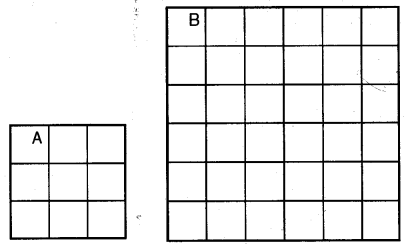
The perimeter of square A is 12 cm.
The side of square B is 6 cm.
The area of square B is 36 square cm.
The area of square B is 4 times the area of square A.
The perimeter of square B is 24 cm.
The perimeter of square B is 2 times the perimeter of square A.
NCERT Solutions for Class 5 Maths Chapter 11 Page 155
Thread Play
1.Take a 15 cm long thread. Make different shapes by joining its ends on this sheet.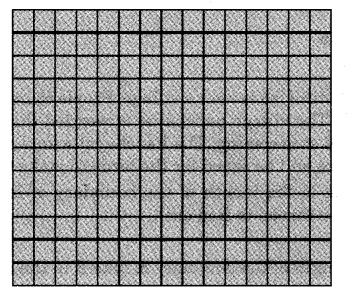
(a)Which shape has the biggest area? How much? What is the perimeter of this shape?
(b)Which shape has the smallest area? How much? What is the perimeter of this shape?
Also make a triangle, a square, a rectangle and a circle.
Find which shape has biggest area and which has the smallest.
Ans. (a) For shape P
Area = (9 + 2 x 1/2 + 7)
= 17 square cm
Number of complete squares = 9 Number of more than half squares = 7 Number of half squares = 2 Area of shape Q
= (2 + 2 x 1/2 + 7)
= 10 square cm Area of shape R
= (9 + 1 x 1/2 + 7)
= 16 (1/2) square cm
So, shape P has the biggest area
Perimeter of this shape is 15 cm (because the length of the thread is 15 cm)
(b) Shape Q has the smallest area.
Perimeter of this shape = 15 cm (because the length of the thread is 15 cm) Area of triangle = (6 + 0 x 1/2 + 6)
= 12 square cm
Area of square = (9 + 0 x 1/2 + 7)
= 16 square cm
Area of rectangle = (10 + 5 x 1/2 + 0)
= 12 square cm
NCERT Solutions for Class 5 Maths Chapter 11 Page 156
Save the Birds
There are two beautiful lakes near a village. People come for boating and picnics in both the lakes. The village panchayat is worried that with the noise of the boats the birds will stop coming. The Panchayat wants motor boats in only one lake. The other lake will be saved for the birds to make their nests.
(а)How many cm is the length of the boundary of lake A in the drawing?……………..(use thread to find out).
Ans. 33 cm
(b)What is the length of the boundary of lake B in the drawing?
Ans. 26 cm
(c)How many kilo metres long is the actual boundary of lake A?
Ans. 33 km 14
(d) How many kilometres long is the actual boundary of lake B?
Ans. 26 km
(e) A longer boundary around the lake will help more birds to lay their eggs. So which lake should be kept for birds? Which lake should be used for boats?
Ans. Lake A should be kept for birds and lake B should be used for boats.
(f) Find the area of lake B on the drawing in square cm. What is its actual area in square km?
Ans. Number of complete squares = 15 Number of half squares = 3 Number of more than half squares = 8
Hence, area = (15 + 3 x 1/2 + 8)
= 24 (i/2) square cm
Hence, actual area of lake B = 24 (1/2) square km
NCERT Solutions for Class 5 Maths Chapter 11 Page 157
King’s Story
The king was very happy with carpenters Cheggu and Anar. They had made a very big and beautiful bed for him. So as gifts the king wanted to give some land to Cheggu, and some gold to Anar.
Cheggu was happy. He took 100 metres of wire and tried to make different rectangles.
He made a 10 m x 40 m rectangle. Its area was 400 square metres.
So he next made a 30 m x 20 m rectangle.
1.What is its area? Is it more than the first rectangle?
Ans. Area of rectangle = 30 x 20 = 600 square metres Yes, it is more than the first rectangle
2.What other rectangles can he make with 100 metres of wire. Discuss which of these rectangles will have the biggest area.
Ans. Following rectangles are possible:
5 m x 45 m = 225 square m
15 m x 35 m = 525 square m
25 m x 25 m = 625 square m
The square will have the biggest area.
3.Cheggu’s wife asked him to make a circle with the wire. She knew it had an area of 800 square metres. Why did Cheggu not choose a rectangle? Explain.
Ans. Because none of the rectangle will have an area of 800 square meter.
NCERT Solutions for Class 5 Maths Chapter 11 Page 158
So Anar also tried many different ways to make a boundary for 800 square metres of land.He made rectangles A, B and C of different sizes. Find out the length of the boundary of each. How much gold wire will he get for these rectangles?
(a)40 m x 20 m
Perimeter = 2(length + breadth) = 2 (40 + 20) = 2 x 60 = 120 m
(b)80 m x 10 m
Perimeter = 2(length + breadth) = 2(80 + 10) = 2 x 90 = 180 m
(c)800 m x 1 m
Perimeter = 2(length + breadth) = 2 (800 + 1) = 2 x 801 = 1602 m
But then Anar made an even longer rectangle See how long!
(d)8000 m x 0.1 m
Perimeter = 2(length + breadth) = 2(8000 + 0.1) = 2 x 8000.1 = 16000.2 m
1.Now do you understand why the king fainted!!
Ans. The king fainted because he could not arrange so much of gold.
2.Can you make a rectangle with a still longer boundary? I made a rectangle 1 cm wide and 80000 m long. Imagine how long that boundary will be!!! With that much gold wire I can become a king!
Ans. Perimeter = 2(length + breadth)
2(80000 m + 1 cm)
= 2(80000 m + 1/100 m)
= 2(80000 m + 0.01 m)
= 2 x 80000.01 m = 16000.02 m










